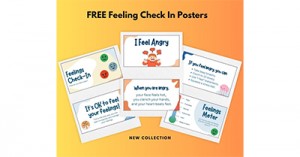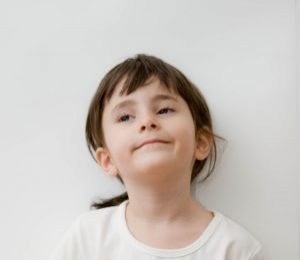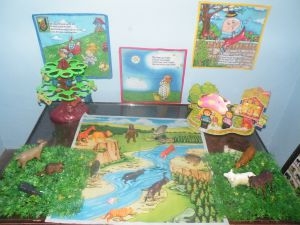A “feelings toolbox” is a collection of strategies, visuals, and resources that help children recognize, express, and regulate their emotions. The following article provides information on What Is A Feeling Toolbox?, Benefits Of A Feeling Toolbox, Feeling Toolbox Tools For Different Age Groups, Effectively Implementing A Feeling Toolbox, Examples For Using The Feelings Toolbox in Real-Life Scenarios and more.
What Is A Feeling Toolbox?
A feeling toolbox is a set of tools—both physical and emotional—that helps children (and even adults) recognize, express, and manage their emotions in healthy ways. Think of it like a first-aid kit, but for feelings.
It might include:
- Visual aids like emotion charts or mood meters to help identify feelings.
- Sensory tools such as stress balls, fidget toys, or calming jars to support self-regulation.
- Coping strategy cards with prompts like “Take three deep breaths” or “Talk to a friend.”
- Books or stories that explore emotions and model empathy.
- Creative outlets like drawing, music, or movement to express what words can’t.
Benefits Of A Feeling Toolbox
A feeling toolbox can have a profound impact on a child’s emotional development—especially in the early years when emotional literacy is just beginning to take shape. Here’s how it supports growth across key domains:
1. Builds Emotional Vocabulary
By using visuals like emotion cards or mood meters, children learn to name and differentiate feelings. This strengthens their ability to communicate needs and reduces frustration-driven behaviors.
2. Enhances Self-Regulation
Tools like breathing prompts, sensory items, or calming jars help children recognize when they’re dysregulated and choose strategies to return to a calm state. Over time, this builds internal coping mechanisms and resilience.
3. Fosters Empathy and Social Skills
When children use the toolbox to reflect on their own emotions, they become more attuned to others’ feelings too. This supports perspective-taking, conflict resolution, and prosocial behavior.
4. Promotes Independence and Agency
Having access to a toolbox empowers children to take charge of their emotional well-being. Instead of relying solely on adults, they begin to self-initiate strategies—boosting confidence and autonomy.
5. Supports Mental Health and Wellbeing
Long-term, children who develop emotional coping skills are better equipped to handle stress, adapt to change, and form healthy relationships. This foundation can reduce the risk of anxiety, aggression, or withdrawal later in life.
Feeling Toolbox Tools For Different Age Groups
Babies (0–12 months)
-
Soft sensory items – textured fabrics, crinkly cloths, or tag blankets
-
Soothing visuals – black-and-white emotion faces or high-contrast cards
-
Gentle music or lullabies – calming auditory input
-
Cuddly comforters – familiar soft toys or family-scented cloths
-
Adult-led co-regulation – rocking, humming, or rhythmic tapping
Toddlers (1–3 years)
-
Feelings flashcards with simple faces and one-word emotions
-
Emotion puppets – great for role-play and naming feelings
-
Bubble bottles – for deep breathing and visual calm
-
“I need…” cards – visual prompts for basic needs (hug, help, space)
-
Soft fidget toys – like squishy balls or textured rings
Preschoolers (3–5 years)
-
Mood meters or thermometers – to gauge intensity of feelings
-
Coping strategy dice – roll to pick a calming action
-
Emotion storybooks – like The Color Monster or When I’m Feeling Angry
-
Calm-down jars – glitter bottles to watch and breathe with
-
Drawing or journaling pages – to express feelings through art
Early Primary (5–8 years)
-
Emotion wheels – to expand vocabulary beyond “happy/sad”
-
Mindful breathing cards – with visuals like “smell the flower, blow the candle”
-
Problem-solving mountain – break down big feelings into steps
-
“What helps me feel better” worksheets – child-led reflection
-
Music playlists – calming or uplifting songs they can choose from
Effectively Implementing A Feeling Toolbox
Using a feeling toolbox effectively means making it a natural, empowering part of your daily rhythm—especially in early childhood settings. Here’s how to bring it to life:
1. Introduce It Proactively
Don’t wait for big emotions to erupt. Introduce the toolbox during calm moments.
-
Use group time to explore each tool.
-
Role-play scenarios where children might use it.
-
Read stories that model emotional regulation and link them to toolbox strategies.
2. Make It Accessible
Keep the toolbox in a visible, child-friendly spot.
- Label it clearly with visuals.
- Use real items (like fidget toys or emotion cards) children can touch and choose from.
- Rotate items based on children’s needs or interests.
3. Model Its Use
Children learn by watching.
- Narrate your own feelings and how you use a tool: “I’m feeling a bit frustrated, so I’m going to take three deep breaths.”
- Encourage educators and families to do the same.
4. Embed It in Routines
Weave it into daily transitions:
- Use it during morning check-ins (“How are you feeling today?”).
- Offer it before rest time or after high-energy play.
- Encourage children to visit it when they need a moment to reset.
5. Reflect and Revisit
Help children build emotional literacy over time:
- Ask, “Did that help you feel better?” or “What else could we try next time?”
- Update the toolbox with children’s input—let them co-create new tools or visuals.
Examples For Using The Feelings Toolbox in Real-Life Scenarios
- Scenario 1: Frustration During Art Time
A child crumples their drawing and says, “I can’t do it!”
Toolbox Use: The educator offers the child a “calm-down card” or encourages them to squeeze a stress ball. After a few deep breaths, the child is invited to try again or choose a different creative outlet.
- Scenario 2: Separation Anxiety at Drop-Off
A child clings to their parent, teary-eyed.
Toolbox Use: The child chooses a comfort item from the toolbox—like a soft toy or a “hug card” with a picture of their family. The educator uses a visual feelings chart to help the child name their emotion and feel seen.
- Scenario 3: Conflict with a Peer
Two children argue over a toy and one shouts, “You’re not my friend anymore!”
Toolbox Use: The educator guides both children to the toolbox area. They use emotion cards to identify how they’re feeling, then choose a coping strategy like “talk it out” or “draw how you feel.” This opens space for repair and empathy.
- Scenario 4: Overstimulation After Outdoor Play
A child returns inside and seems agitated—pacing, fidgeting, or covering their ears.
Toolbox Use: The child is invited to the quiet corner with sensory tools like a weighted lap pad or calming jar. They might listen to soft music or use a visual breathing prompt to self-regulate.
- Scenario 5: Story Time Reflection
After reading a book about a character who feels left out, a child says, “That happened to me.”
Toolbox Use: The educator offers a journaling page or drawing sheet from the toolbox. The child expresses their experience and chooses a strategy card like “ask for help” or “tell someone how you feel.”
Further Reading
Calm Down Box For Children
Calm Down Techniques For Overresponsive Children
Understanding Temperament In Children
30 Emotional Regulation Activities For Toddlers and Preschoolers
Reset Activities For Children After A Tantrum Or Meltdown







 Open ended questions cannot be responded to with one word answers such as yes or no. These types of questions enables a child to provide
Open ended questions cannot be responded to with one word answers such as yes or no. These types of questions enables a child to provide During your child’s preschool years, an important milestone begins to emerge. This is the development of pre-writing skills. Pre-writing skills are used to encourage, develop
During your child’s preschool years, an important milestone begins to emerge. This is the development of pre-writing skills. Pre-writing skills are used to encourage, develop Open ended materials enables children to play freely. They are objects that have no rules to follow, use or function. Raw materials that can be
Open ended materials enables children to play freely. They are objects that have no rules to follow, use or function. Raw materials that can be An Acknowledgment of the Country is a way of showing respect for the Traditional Owners and can be given by both non-Indigenous people and Aboriginal
An Acknowledgment of the Country is a way of showing respect for the Traditional Owners and can be given by both non-Indigenous people and Aboriginal Language plays an important role in a child’s development. It enables a child to communicate effectively with their family, learn at school, socialize with friends,
Language plays an important role in a child’s development. It enables a child to communicate effectively with their family, learn at school, socialize with friends, Like adults, children have to deal with their own stress in life. Moving house, starting a new school, preparing for a new sibling - these are
Like adults, children have to deal with their own stress in life. Moving house, starting a new school, preparing for a new sibling - these are Playdough is such a versatile material. It provides numerous benefits to children as they manipulate it, it is safe and soothing and provides children with
Playdough is such a versatile material. It provides numerous benefits to children as they manipulate it, it is safe and soothing and provides children with Teaching children about sustainability enables them to appreciate and respect the natural environment. Early childhood services can provide meaningful hand on learning experiences in order
Teaching children about sustainability enables them to appreciate and respect the natural environment. Early childhood services can provide meaningful hand on learning experiences in order Recycling is an important concept that teaches children to care for the environment. It encourages children to be responsible and show a growing appreciating for
Recycling is an important concept that teaches children to care for the environment. It encourages children to be responsible and show a growing appreciating for When children apply paint to paper, glue things together, or pound a lump of clay, they experiment with colour, shape design and texture.
When children apply paint to paper, glue things together, or pound a lump of clay, they experiment with colour, shape design and texture.



